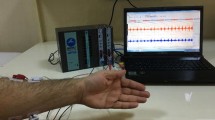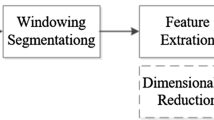Abstract
Various myoelectric prostheses controlled by electromyography (EMG) signals have been developed. However, there have been few studies that provide fast and accurate methods to predict handgrip force from EMG signals. Rapid and precise handgrip force prediction is required, especially for the real-time control system of myoelectric prostheses. In this study, extreme learning machine (ELM) is applied to predict handgrip force from surface EMG signals of forearm muscles. Furthermore, ELM is compared with support vector machine (SVM) and multiple nonlinear regression (MNLR). The below 10 % of the surface EMG and handgrip force signals were cut away, and then the root mean square feature extracted from the modified surface EMG signals was taken as input vector for these three kinds of predicting mechanisms. For the testing dataset, ELM achieved a slightly larger root mean squared error than SVM did and a smaller one than MNLR did. Meanwhile, all three methods showed high correlation coefficients. For the total processing time, ELM and MNLR consumed much less time than SVM did. Experimental results demonstrate that ELM possesses a relatively good accuracy and little consumed time, although SVM is effective for handgrip force estimation in terms of accuracy. Overall, ELM has a promising potential for predicting handgrip force rapidly and precisely.









Similar content being viewed by others
Explore related subjects
Discover the latest articles, news and stories from top researchers in related subjects.References
Andris F (2004) Biomechanics of the upper limbs: mechanics, modelling and musculoskeletal injuries. CRC Press, Boca Raton
Chen Y, Zhao Z, Wang S, Chen Z (2012) Extreme learning machine-based device displacement free activity recognition model. Soft Comput 16:1617–1625
Corinna C, Vladimir V (1995) Support-vector networks. Mach Learn 20(3):273–297
De Carlo LJ (1997) The use of surface electromyography in biomechanics. J Appl Biomech 13(1):135–163
Emer PD, Madeleine ML, David PF, Mark JO (2008) Effect of elbow joint angle on forcecemg relationships in human elbow flexor and extensor muscles. J Electromyogr Kinesiol 18(1):760–770
Eric B, Trevor H, Debashis P, Robert T (2006) Prediction by supervised principal components. J Am Stat Assoc 101(473):119–137
Farid M, Keyvan HZ (2005) Rowing stroke force estimation with EMG signals using artificial neural networks. In: Proceedings of the 2005 IEEE conference on control applications, pp 825–830
Göran MH, Alwin L, Matthias J (2000) Methodologies for evaluating electromyographic field data in ergonomics. J Electromyogr Kinesiol 10:301–312
Haritha S, Sauvik G, Weihua S (2012) Estimation of hand force from surface electromyography signals using artificial neural network. In: Proceedings of the 10th world congress on intelligent control and automation, IEEE, pp 584–589
Harshvardhan V, Emken BA, Schroeder ET, Donna SM, Sukhatme GS (2013) Hierarchical linear models for energy prediction using inertial sensors: a comparative study for treadmill walking. J Ambient Intell Hum Comput 4:747–758
Huang G (2003) Learning capability and storage capacity of two-hidden-layer feedforward networks. IEEE Trans Neural Netw 14(2):274–281
Huang G, Zhu Q, Siew Ck (2006) Extreme learning machine: theory and applications. Neurocomputing 70(1–3):489–501
Huang G, Wang D, Lan Y (2011) Extreme learning machines: a survey. Int J Mach Learn Cybern 2(2):107–122
Huang G, Babri HA (1998) Upper bounds on the number of hidden neurons in feedforward networks with arbitrary bounded nonlinear activation functions. IEEE Trans Neural Netw 9(1):224–229
Huang G, Zhu Q, Siew Ck (2004) Extreme learning machine: a new learning scheme of feedforward neural networks. In: Proceedings of international joint conference on neural networks, pp 985–990
Ion M, Manuel G (2012) Face recognition with lattice independent component analysis and extreme learning machines. Soft Comput 16:1525–1537
Jakob RM, Mette FB, Ema E, Marko JN, Anne S, Ernest NK (2010) Prediction of grasping force based on features of surface and intramuscular EMG. 7th semester conference paper, pp 1–9
Jeremy PMM, Peter JK (2006) Prediction of forearm muscle activity during gripping. Ergonomics 49(11):1121–1130
Julie D, Dominique M, Jacques M (1995) Evaluation of handgrip force from EMG measurements. Appl Ergon 26(1):61–66
Khandoker A, Palaniswami M, Karmakar CK (2009) Support vector machines for automated recognition of obstructive sleep apnea syndrome from ECG recordings. IEEE Trans Inf Technol Biomed 13(1):37–48
Lee CC, Shi CY, Lai WP, Lin PC (2012) An improved boosting algorithm and its application to facial emotion recognition. J Ambient Intell Hum Comput 3:11–17
Marco JH, Jaap HvD (2005) Prediction of handgrip forces using surface emg of forearm muscles. J Electromyogr Kinesiol 15(4):358–366
Marta MC, Joaqułn LSB, Prez-Gonzlez A (2012) Hand posture prediction using neural networks within a biomechanical model. Int J Adv Robot Syst 9(139):1–11
Mojgan T (2010) Analysis of hand force by EMG measurements. Simon Fraser University
Netta G, Allison O (2007) Human performance in a knob-turning task. In: IEEE world haptics conference, pp 96–101
Nor AJ, Shahrul NS, Abu US (2013) Neuro-based thumb-tip force and joint angle modelling for development of prosthetic thumb control. Int J Adv Robot Syst 10(339):1–8
Pau CH, Bong-Sup P, Jeong-Su K (2011) Physiological decrements during sustained military operational stress. Mil Med 176(9):991–997
Peter JK, Jeremy PM (2005) The development and validation of equations to predict grip force in the workplace: contributions of muscle activity and posture. Ergonomics 48(10):1243–1259
Pradeep S, Kai JM, Beau C, Rajesh PNR (2008) Online electromyographic control of a robotic prosthesis. IEEE Trans Biomed Eng 55(3):1128–1135
Richard WB, Anneli P, Nicola MW, Johanne D, Jane BL (2006) Reference values for adult grip strength measured with a jamar dynamometer:a descriptive meta-analysis. Physiotherapy 92(1):11–15
Rosa-filho JS, Bemvenuti CE, Ellott M (2004) Predicting biological parameters of estuarine benthic communities using models based on environmental data. Braz Arch Biol Technol 47(4):613–627
Sébastien D, William B, Jean-Noël P, Frédéric G (2008) Muscular activity during uphill cycling effect of slope, posture, hand grip position and constrained bicycle lateral sways. J Electromyogr Kinesiol 18(1):116–127
Shahrul NS, Ahmad JHM (2012) Mapping of emg signal to hand grip force at varying wrist angles. In: 2012 IEEE EMBS international conference on biomedical engineering and sciences, pp 648–653
Shivajirao J, Sanjay N, Ashok G (2014) Feature elimination based random subspace ensembles learning for ECG arrhythmia diagnosis. Soft Comput 18:579–587
Sung PC, Hsu CC, Lee CL, Chiu PYS, Chen HL (2015) Formulating grip strength and key pinch strength prediction models for taiwanese: a comparison between stepwise regression and artificial neural networks. J Ambient Intell Hum Comput 6:37–46
Xie SJ, Yang J, Gong H, Yoon S, Park DS (2012) Intelligent fingerprint quality analysis using online sequential extreme learning machine. Soft Comput 16:1555–1568
Yang D, Zhao J, Gu Y, Jiang L, Liu H (2009) Estimation of hand grasp force based on forearm surface emg. In: Proceedings of the 2009 IEEE international conference on mechatronics and automation, pp 1795–1799
Acknowledgments
This study is partly supported by the National Natural Science Foundation of China (61303137), the Fundamental Research Funds for the Central Universities(2014QNA5009), and the Specialized Research Fund for the Doctoral Program of Higher Education(20130101110148).
Author information
Authors and Affiliations
Corresponding author
Additional information
Communicated by V. Loia.
Rights and permissions
About this article
Cite this article
Cao, H., Sun, S. & Zhang, K. Modified EMG-based handgrip force prediction using extreme learning machine. Soft Comput 21, 491–500 (2017). https://doi.org/10.1007/s00500-015-1800-8
Published:
Issue Date:
DOI: https://doi.org/10.1007/s00500-015-1800-8




